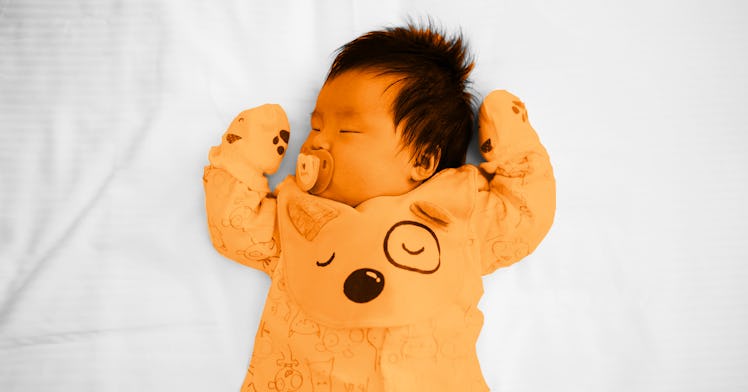How and When to Introduce a Baby Pacifier So They Can Self-Soothe
Parents need to look for a consistent pattern of feeding before popping in the pacifier — and not freak out if the baby doesn't self-soothe.

Baby pacifiers and newborn pacifiers provide babies comfort between feedings. These suckable security blankets not only help with sleep and fussiness but newborn pacifiers can also help in preventing Sudden Infant Death Syndrome. The baby uses a pacifier to self-soothe and parents get to relax with a self-soothed baby. It’s simple to understand how and when to introduce a baby pacifier.
Be the first to get Fatherhood — our comprehensive guide to birth, budgeting, and becoming a happy parent — available for preorder now!
When to Introduce a Pacifier
“There is no magic to introducing the pacifier,” says pediatrician Dr. Karen Breach of the Carolinas HealthCare System. That said, there are some general guidelines. It’s tempting for parents to resort to using the pacifier after the first seemingly endless night of feedings, just to get some sleep. Don’t. Doctors stress that it’s essential to wait until there’s a solid feeding pattern, complete with established latching, before switching to the pacifier plug.
And once you’re ready, “just give it to them,” says Breach. “Babies will suck whatever you put in their mouths, so you just give it to them when they seem to be fussy and they don’t need anything else — they don’t seem hungry and their diapers are clean — just give it to them.”
Some kids simply won’t take to the pacifier, and that’s okay as well. They’ll very likely suck on their fingers (or their parents’ fingers) in between feedings. Digit sucking carries its own antiquated stigma, but it’s a natural instinct. “Babies have a natural need to suck,” Breach says. “Sucking is one of the earliest instincts, and it’s a comfort mechanism.”
Beyond simple comfort and satisfying instincts, pacifiers (or any other oral apparatus or digit children choose) serve myriad purposes, among them quelling often misguided (though well-intentioned) parental instincts. When a baby cries, parents generally think that she or he is either soiled or hungry. The instinct, then, is to immediately present a breast or bottle. That can lead to overfeeding, Breach says, which results in discomfort, dreaded diaper blowouts, and also establishes an early path to childhood obesity.
How to Introduce a Baby Pacifier
- Wait until a consistent feeding pattern has been established so as not to derail breastfeeding.
- Simply offer the child a pacifier by putting it in their mouth.
- Don’t worry if a child prefers to use their fingers rather than a pacifier.
- There is no need to take the pacifier away before 3 years old.
When to Take Away a Baby Pacifier
Often, the baby is simply seeking comfort, and that comfort comes from sucking. The comforts provided by a baby pacifier extends to parents, who experience a little calm and quiet — right up until the thing must be taken away. And any pacifier will eventually have to be taken away.
Still, Breach says that parents shouldn’t be in too big a rush to wean their children off the pacifier if they find comfort in it. Considering the life-altering milestones that hit in rapid succession — walking, potty-training, big-kid beds — she says parents shouldn’t feel bad about keeping a pin in their little grenades, particularly when they’re taken out of their comfort zones. Age three is a solid target for ditching the paci, but if a pacifier needs to resurface from time to time, Breach says that’s fine.
“I am not bothered when parents come in with a 2-year-old with a pacifier. If the child is out of its comfort zone, if that calming device is needed, it’s ok,” she says. “I don’t really like seeing a kid talking around a pacifier, but it won’t go until kindergarten, it really won’t. Many children just let it go [on their own].”
This article was originally published on